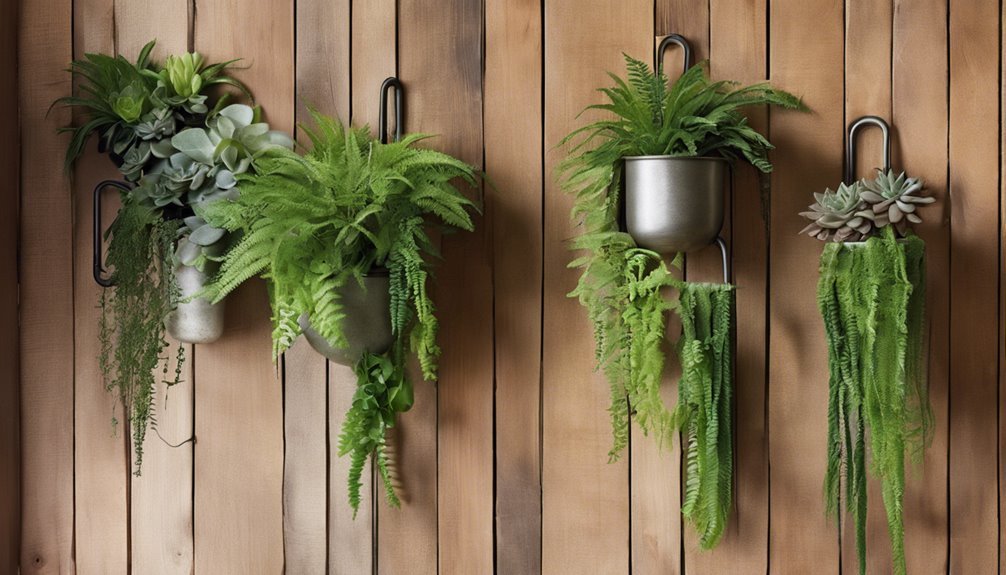Hanging Hooks for Vertical Garden Designs
The Benefits of Vertical Gardening
While you might think that limited space restricts your gardening options, vertical gardening offers a creative solution that maximizes your available area. This innovative approach enhances space efficiency, allowing you to grow a variety of plants in a smaller footprint. By utilizing vertical structures, you're not just expanding your gardening potential; you're also contributing positively to the environment. Vertical gardens improve air quality, reduce heat, and promote biodiversity by attracting beneficial insects. They can even help insulate buildings, leading to energy savings. Imagine lush greenery cascading down your walls, transforming your space into a vibrant oasis. With vertical gardening, you can cultivate your passion for plants while enjoying the environmental benefits and the freedom of utilizing every inch of your home.
Choosing the Right Hanging Hooks
When it comes to vertical gardening, selecting the right hanging hooks is essential for guaranteeing your plants thrive. You should consider various hook materials, such as stainless steel for durability or plastic for lightweight options. Each material offers different aesthetics and weather resistance, so choose one that matches your garden's style and environmental conditions. Furthermore, pay close attention to the weight capacity of each hook. Confirm it can support the combined weight of your pots, soil, and plants without risk of failure. Remember, a sturdy hook not only keeps your setup secure but also allows for creative freedom in arranging your vertical garden. With the right hooks, you can cultivate a flourishing and visually stunning green space.
Types of Plants Suitable for Vertical Gardens
If you want to create a thriving vertical garden, choosing the right types of plants is essential. Opt for herb varieties like basil, mint, and thyme; they're not only aromatic but also perfect for limited space. These herbs thrive in vertical setups, offering both culinary uses and vibrant greenery. Additionally, consider incorporating flowering plants such as petunias, begonias, or nasturtiums. They add visual interest and attract pollinators, enhancing your garden's ecosystem. When selecting plants, think about their light and water requirements, ensuring they match your vertical garden's conditions. With the right combination of herbs and flowering plants, you'll create a lush, diverse vertical garden that breathes life into your space, embracing the freedom of nature in your home.
Creative Ways to Arrange Your Plants
Arranging your plants creatively can transform a simple vertical garden into a stunning focal point. You can express your style through thoughtful plant pairings and color combinations. Here are some ideas to inspire you:
- Layer heights: Mix trailing plants with upright varieties for depth.
- Color gradients: Arrange plants based on color changes, creating a visual flow.
- Themed sections: Group plants by color, texture, or growth habits to create unique zones.
- Contrasting foliage: Pair plants with bold leaves against delicate blooms for striking contrasts.
- Seasonal swaps: Change plants seasonally to keep your garden fresh and vibrant.
These creative arrangements will not only enhance your vertical garden but also reflect your personal aesthetic. Enjoy the freedom to experiment!
DIY Vertical Garden Projects With Hooks
Creating a vertical garden using hooks can elevate your gardening experience, allowing you to maximize space while showcasing your plants in unique ways. For DIY vertical garden projects, consider using sturdy hooks to suspend planters or pots against walls. You can easily enhance your vertical designs by selecting hooks that match your aesthetic—think rustic, modern, or minimalist. Arrange your plants by height and sunlight needs, ensuring each one thrives. Wall-mounted grids or trellises are excellent for supporting climbing plants, while hanging baskets can add layers of texture. Using hooks not only saves ground space but also invites creativity, turning any wall into a lush living tapestry. Embrace the freedom of customization and let your garden flourish upward!
Maintenance Tips for Hanging Gardens
Maintaining your hanging garden is essential for its health and longevity. You'll need to establish a regular watering schedule to keep your plants hydrated, as hanging arrangements can dry out quickly. Additionally, implementing effective pest control strategies will help prevent infestations that could harm your greenery.
Regular Watering Schedule
Although hanging gardens can add a stunning visual element to your space, they require a regular watering schedule to thrive. Keeping your plants hydrated is essential for their health. Here are some effective watering techniques to maintain ideal plant hydration:
- Check soil moisture: Use your finger to feel if the top inch is dry.
- Water early or late: Avoid the midday sun to reduce evaporation.
- Use a drip system: This guarantees consistent moisture without overwatering.
- Rotate plants: Move them to ensure even water exposure.
- Monitor weather conditions: Adjust your schedule based on rainfall and temperature.
Pest Control Strategies
Keeping your hanging garden healthy goes beyond just watering; pest control is an essential aspect of maintenance. To protect your plants, start by identifying natural pests early. Regularly inspect your foliage for signs of infestations, like discolored leaves or webbing. When you spot trouble, consider organic solutions that keep your garden thriving. Neem oil and insecticidal soap are excellent choices, effectively targeting pests without harming beneficial insects. Introduce companion planting to deter unwanted visitors; herbs like basil or marigolds can naturally repel pests. Additionally, maintaining good air circulation and proper spacing in your hanging arrangements reduces the likelihood of outbreaks. By implementing these strategies, you'll enjoy a vibrant, pest-free garden that allows your plants to flourish.
Incorporating Decor Into Your Vertical Garden
To create a truly enchanting vertical garden, you can seamlessly blend decorative elements that enhance both its aesthetic appeal and functionality. Incorporating decor doesn't just beautify; it also reflects your personal style. Consider these ideas:
- Colorful Planters: Use unique, vibrant pots to add character.
- Wall Art: Hang intriguing pieces that complement your greenery.
- Lighting: Install fairy lights or lanterns for a magical ambiance.
- Shelving: Add floating shelves for displaying small decor items or books.
- Natural Textures: Incorporate wooden elements or stones to create a harmonious look.
Common Mistakes to Avoid in Vertical Gardening
Creating a stunning vertical garden can be rewarding, but it's important to steer clear of common pitfalls that can undermine your efforts. One major mistake is overwatering; excess moisture can lead to root rot and unhealthy plants. Instead, always check the soil moisture before adding more water. Another frequent issue is inadequate sunlight. Many plants require a certain amount of light, so be sure to place your vertical garden in a location that receives adequate sunlight throughout the day. Additionally, avoid overcrowding your plants; they need space to grow and breathe. Finally, neglecting to choose the right plants for your environment can result in failure. By avoiding these common mistakes, you'll create a thriving vertical garden that truly stands out.
Frequently Asked Questions
Can I Use Regular Hooks for Heavy Plants?
If you're envisioning your hooks lifting mountains of heavy plants, think again! Regular hooks may falter under that weight. Always check the hook weight limit to guarantee proper heavy plant support and avoid disaster.
How Do I Prevent Hooks From Damaging My Walls?
To prevent hooks from damaging your walls, consider using wall protection methods like adhesive alternatives. These options allow you to securely hang items without leaving marks or holes, giving you the freedom to reimagine your space.
What Weather Conditions Affect Hanging Hooks?
Did you know that wind speeds over 20 mph can greatly impact stability? When choosing hooks, consider wind resistance and moisture exposure; both can weaken structural integrity, causing damage or failure over time.
Are There Specific Hooks for Indoor Vs Outdoor Use?
Yes, there are specific hooks for indoor and outdoor use. Indoor hooks typically feature softer materials to avoid damage, while outdoor hooks are designed to withstand weather conditions, ensuring your plants hang securely and thrive wherever you place them.
How Do I Replace Hooks Without Disrupting My Plants?
When it comes to replacing hooks without disrupting your plants, you'll want to tread lightly. Choose the right hook types, and prioritize gentle plant care. Use a soft touch to avoid uprooting your beloved greens.







